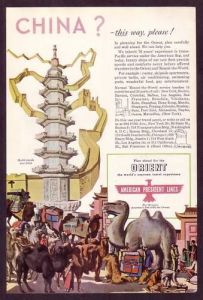Posted: March 2nd, 2015 | 1 Comment »
Scoones crammer school is a much underwritten about place that constantly crops up in memoirs. As most memoirists choose not to go into much detail about the place I can only assume that, in the late nineteenth century, it was a well known institution.
Anyway, here’s a bit of background. Scoones was a crammer for those seeking to enter service in the Foreign Office. It was located at Garrick Chambers on Garrick Street near Covent Garden and next door to the Garrick Club. I first came across it when researching the background of Pamela Werner’s adoptive father ETC Werner, who crammed at the school in the 1880s and passed the Foreign Office entrance exams for a Far Eastern Cadetship and was subsequently sent to Peking as a student interpreter for two years. I had also known that Werner was acquainted with the Africa Hand and writer H. Rider Haggard but was not quite clear on how the two met, given that Haggard never visited China and (though his sister was an early Africa hand at London University) Werner had never visited Africa. Recently happening to glance through Rider Haggard’s autobiography The Days of My Life (Volume 1, published 1926) I noticed that Haggard had also attended Scoones (though dropped out and went to Africa before taking his final exams) and claimed that he made many friends for life. Werner must clearly have been one of these as Haggard later seconded Werner for membership of the Athenaeum Club in London. Incidentally Haggard also recalls having attended séances and spiritualist meetings with other Scoones’ students in St James’s and Hanover Square – both Werner and Haggard retained lifelong interests in séances and spiritualism. As much as their backgrounds at good school (Werner at Tonbridge and Haggard at Ipswich Grammar) being a Scoones graduate provided networks that survived and helped each other for decades within the FO.
Back to Scoones – it was run by William Baptiste Scoones, who was known for getting even the worst dullards through the FO exams and into postings. The curriculum was overseen by André Turquet (1869-1940), the French-born director of Scoones. Many of Scoones “crack team†of teachers were well known too – for instance John Churton Collins, taught Latin at Scoones by day and wrote scathing reviews of literature for the Quarterly Review by night. Apparently though the pay was not good and Collins, like other employees, recalled existing on the poverty line. It’s a little confusing but I think, sometime in the early twentieth century the crammer was taken over by a Mr Diptitch Scoones, perhaps the son of William Baptiste.
One candidate recalled than in 1893 he was told that all but one of the successful FO candidates had attended Scoones. At Scoones pupils (usually arriving when 18) were tutored hard in recommended texts for the entrance exam including Smith’s Wealth of Nations, Mill’s Principles of Political Economy as well as German, French and Latin and how to answer the infamous “Catch†questions that the FO examiners famously set. The pupils were reasonably well off – often second sons with an annual income (required by the FO and on top of Mr Scoones apparently not inconsiderable fees and London lodging fees for the duration of their studies) and lived rather wild lives with drinks at The Fielding Club, regular trips to the Gaiety and Savoy theatres as well as indulging in séances!
Afraid I don’t know much more about SCoones, except that a large number of those men who entered the China section of the Foreign Office and served decades in China (like ETC Werner) must have passed through Mr Scoones’s establishment on Garrick Street. I rather think it deserves a book….

Andre Turquet – Director Scoones (I think!)
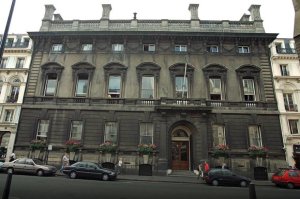
The Garrick Club
And Garrick Street today…
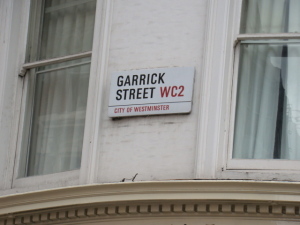
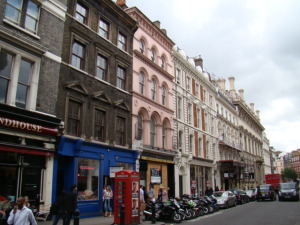
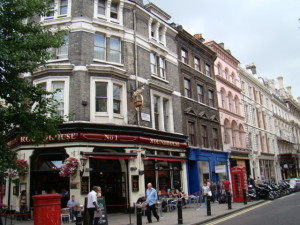
Posted: March 1st, 2015 | No Comments »
The US First edition of Sax Rohmer’s The Mask of Fu Manchu, published in 1932 by The Crime Club. The Mask of Fu Manchu was originally published as a twelve part serial in Collier’s magazine from May 7, 1932 through July 23, 1932. The cover of the May 7 issue utilised artwork by W. T. Benda (on whom more here)….

Posted: March 1st, 2015 | No Comments »
Now in paperback and a great read….

n 1659, a vast and unusual map of China arrived in the Bodleian Library, Oxford. It was bequeathed by John Selden, a London business lawyer, political activist, former convict, MP and the city’s first Orientalist scholar. Largely ignored, it remained in the bowels of the library, until called up by an inquisitive reader. When Timothy Brook saw it in 2009, he realised that the Selden Map was ‘a puzzle that had to be solved’: an exceptional artefact, so unsettlingly modern-looking it could almost be a forgery.
But it was genuine, and what it has to tell us is astonishing. It shows China, not cut off from the world, but a participant in the embryonic networks of global trade that fuelled the rise of Europe – and which now power China’s ascent. And it raises as many question as it answers: how did John Selden acquire it? Where did it come from? Who re-imagined the world in this way? And most importantly – what can it tell us about the world at that time?
Brook, like a cartographic detective, has provided answers – including a surprising last-minute revelation of authorship. From the Gobi Desert to the Philippines, from Java to Tibet and into China itself, Brook uses the map (actually a schematic representation of China’s relation to astrological heaven) to tease out the varied elements that defined this crucial period in China’s history.
Posted: February 27th, 2015 | 4 Comments »
A nice advert for the old Hotel des Colonies on the Rue du Consulat (Jingling Road now though the hotel is long gone) in Frenchtown showing its rather sumptuous interior….

Posted: February 26th, 2015 | No Comments »
An impressive shot of Kiukiang Road (now Jiujiang Road) in the 1920s reflecting the whole “Wall Street of the East” image the city built up….

Posted: February 25th, 2015 | No Comments »

Understanding China, the Country and the Myth
Writer and broadcaster Isabel Hilton who has written extensively on China will be joined in conversation by Anne Witchard, whose research investigates changing conceptions of China in Britain. They will be joined by Jonathan Fenby, author of Will China Dominate the 21st Century?,  to discuss one of the most influential countries in the world today.
More details here

Posted: February 24th, 2015 | No Comments »
In 1930 or thereabouts a circus visited Shanghai and camped out on some waste land behind the Astor House Hotel in Hongkew. However, security was not all it might have been and a wild tiger, part of the show, escaped and sought freedom in the lanes and alleyways north of the Soochow Creek. It first came to the Shanghai Municipal Police’s attention when it scratched a rickshaw puller who was sleeping next to his vehicle down near the Bund. Not too badly as the puller made it the Central Station (which means he couldn’t have been that badly scratched or alarmed as the Central Station was across the Soochow Creek, over the Garden Bridge and up on Foochow Road – Fuzhou Road if you prefer).
A police officer (called Conning in some accounts – though no officer of that name was ever in the SMP to my knowledge) headed over the wasteland behind the Astor with a nice piece of bloody steak – tied it to a stake and sat back and waited to see if the tiger would appear. The European officer took along a Sikh constable with him. They eventually found the tiger in the Summer House at the Public Gardens on the Bund, what is ow Huangpu Park.
Approaching the Summer House the European officer lobbed in the bloody steak to entice the tiger out and grapsed the rope ready to haul in the beast. Rather than wait and see what the plan was once the copper had a live tiger, that had tasted blood, on the end of a short rope the Sikh officer rather wisely took out his .455 revolver and shot it.

The old Public Gardens on the Bund with the summer house where the tiger lurked to the left of the bandstand
Posted: February 23rd, 2015 | No Comments »
Get a last gasp of China before it goes Red and Commie in the late 1940s with American President Lines….tourism was about to be off the Maoist agenda!!
